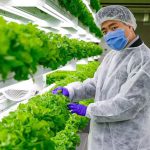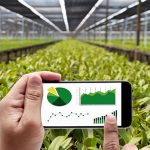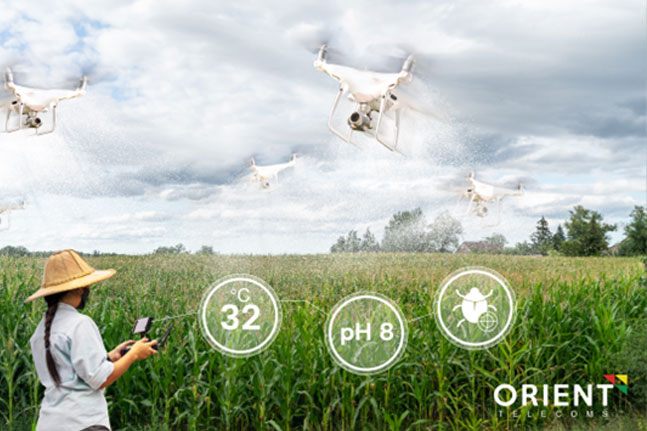
A BEGINNER’S GUIDE TO SUSTAINABLE FARMING
October 22, 2023
5 TOOLS AND TECHNOLOGIES THAT DRIVE SUSTAINABLE AGRICULTURE
December 19, 2023Climate change can have a direct impact on agricultural production. Climate parameters —including extreme storm events, heat waves, pests, and droughts— can potentially pose productivity risks to on-farm practices. In this article, we will share some insights on how to use technology to combat climate change in the agriculture industry and how technological innovation can transform the stages of food production from field to fork.
Growing population and changing food habits could potentially drive up the demand for food. However, production may be struggling to meet needs as climate change has reduced global agricultural productivity by 21%, according to a report by Nature Climate Change.
Because of this, agricultural practices should potentially evolve to reduce their environmental impact and adopt new techniques to manage growing demand. For example, farmers can use farm management software to aid in building farm plans and anticipating optimal resource requirements and the impact of climate change on crops.
The Government of Canada is taking various steps to leverage technology to help farmers tackle the impact of climate change on agriculture, which we discuss in the sections below. In this context, innovative climate change mitigation technology can potentially play a crucial role in reducing emissions and enhancing climate resiliency.
WHAT IS THE IMPACT OF CLIMATE CHANGE ON AGRICULTURE?
Climate change can impact agriculture in different ways, including rapid changes in average temperatures, rainfall, climate extremes, the nutritional quality of foods, and ground-level ozone concentrations. Below, we list some of the different ways climate change can impact agriculture:
UNCERTAIN WEATHER CAN AFFECT FARM PRODUCTION
The high speed of climate change combined with increasing population and income growth may harm food production in many countries. For example, higher temperatures can reduce the yields of desirable crops while promoting pest and weed proliferation. Managing pests in such conditions may be challenging, resulting in increased pesticide usage to achieve the optimal level of control. Also, heavy rains that often lead to flooding may harm crops and the soil structure. Plants cannot survive prolonged waterlogged conditions as roots have to breathe.
HIGHER CO2 LEVELS CAN IMPACT CROP YIELDS AND FISHERIES
Gradual increases in carbon dioxide can lower concentrations of minerals and proteins in plant species such as soybeans, rice, and wheat. Rising CO2 levels impacting the nutritional value of crops can potentially pose a threat to human health.
Increased levels of atmospheric carbon dioxide can also make oceans acidic which, in turn, could harm shellfish and weaken their shells. This may lead to a reduced harvest for fishermen and potential consumer price changes.
HEAT WAVES CAN AFFECT LIVESTOCK PRODUCTION
Heat waves can impact animals in many ways. In fact, as per a report by the Vancouver Sun, due to previous heat wave instances, at least 651,000 animals died on farms, mainly chicken and other poultry birds. Extreme heat waves can result in increased vulnerability to disease, reduced milk production, and decreased fertility.
HOW TO USE TECHNOLOGY TO COMBAT CLIMATE CHANGE IN AGRICULTURE
From deciding the right time to grow any crop to harvesting it, implementing innovative agriculture practices can enable farmers to drive climate resilience. In this section, we list some pointers to help do this.
KEEPING A TAB ON CHANGEABLE WEATHER CONDITIONS
Though an optimum level of rainfall at the right time is crucial in agriculture, an unforeseeable monsoon may signal climate change. Farmers can leverage the potential of advanced weather forecasting features like agro-climate interactive maps that present datasets for temperature, precipitation, and other weather-related variables. Using such technology, they can get weather-related and plan cultivation cycles beforehand.
USING DATA-DRIVEN INSIGHTS TO IMPROVE CROP PRODUCTIVITY
The data-driven farming approach usually comprises different modern technologies that can help gather accurate and precise farm data by using:
- Soil and crop sensors: to measure water content in the soil and evaluate crop conditions for better decision-making
- Auto-steer: using geographic information system (GIS) and global positioning system (GPS) to guide tractors and other farm equipment to move and harvest fields more accurately
- Variable rate technology: allows farmers to use fertilizers and plant seeds at different rates across a farming field by using geolocation technology that helps locate optimal sowing locations in the field
HANDLING PESTS AND DISEASES PROACTIVELY
Implementing smart farming strategies can help farmers keep track of their farms in real-time. In case they encounter an unpredictable outbreak of disease or pests across any part of the farm, technology can potentially help deliver timely intervention to mitigate risk before it spreads to the rest of the farm. Measuring risk before it affects the farm area can be a helpful strategy for farmers.
BUILDING SUSTAINABLE PRACTICES WITH EMERGING TECH
Emerging technology such as artificial intelligence (AI), internet of things (IoT), and data analytics can help farmers and other stakeholders capture and analyze carbon dioxide emissions before they are released into the atmosphere and create a circular economy. For example, using data analytics can help provide farmers insights into organic waste that can be reused to make fertilizers, thereby making the agriculture industry more sustainable.
USING EARTH OBSERVATION DATA TO IMPROVE PRODUCTIVITY
Data captured through earth observation (EO) can help provide a clear picture of climate change across the planet. Satellite-derived data can turn out to be crucial in agricultural environment monitoring and can be used by farmers for different purposes, including:
- Crop health management and monitoring
- Crop type determination
- Yield estimates
- Irrigation requirements and applications
- Agri-environmental monitoring
- Field-scale mapping
WHAT IS EARTH OBSERVATION (EO) DATA?
Earth observation data can be defined as the information captured through satellites about the Earth’s chemical, biological, and physical properties. This data is usually used to track changes in the Earth’s artificial and natural resources.
WHAT IS AGRI-ENVIRONMENTAL MONITORING?
It is a parameter that assesses how agriculture impacts environmental quality.
WHAT IS FIELD-SCALE MAPPING?
Field-scale mapping can help farmers get insights into how they can utilize limited water resources to maintain productivity and mitigate the impact of climate change.
HOW IS THE CANADIAN GOVERNMENT ADDRESSING CLIMATE CHANGE ISSUES?
The Government of Canada is making critical investments to help farmers tackle climate change, reduce GHG emissions, and create a low-carbon future. Following are some of the efforts that have been made toward strengthening the agriculture sector in Canada:
- Launched in March 2022, the 2030 Emissions Reduction Plan is the government’s initiative to accelerate the growth of the agriculture sector with an aim to reduce emissions to “40 percent below 2005 levels by 2030 and net-zero emissions by 2050”.
- The Government of Canada has also planned to invest an additional $330 million in the Agricultural Clean Technology (ACT) Program to expand the development and acquisition of clean technology in the sector. The program encourages sustainable growth in Canada’s agri-food and agriculture sectors.
- To combat climate change in agriculture, the Canadian Government has launched nine new living labs that will focus on identifying technologies and on-farm management solutions to help farmers respond to climate change in agriculture.
CONCLUSION
To handle increasing food demands and adapt to climate change, farmers should potentially implement new technology and climate management practices. From monitoring soil conditions to tracking crop health, predicting long-term weather, and improving food production, such techniques can potentially help in responding to the impact of climate change on agriculture.
https://www.getapp.ca/blog/3317/technology-combat-climate-change-in-agriculture





